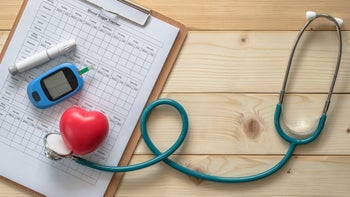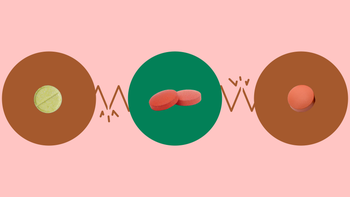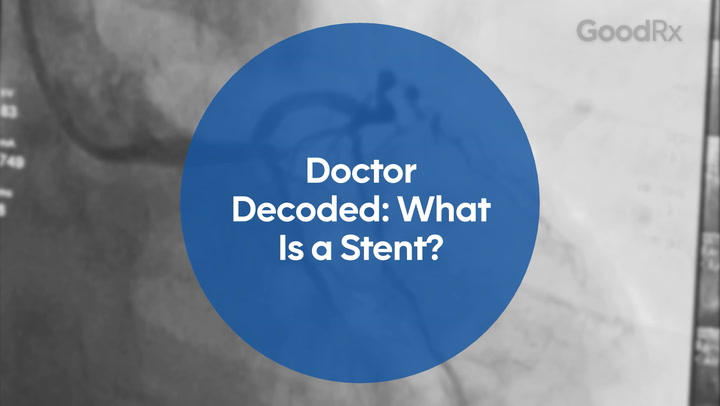
Treatment for Heart Attacks
A GoodRx guide to stenting, medication, and other heart attack treatments
What is a heart attack?
A heart attack is a serious medical condition. The heart is surrounded by blood vessels, called the coronary arteries. During a heart attack, one or more of these blood vessels becomes narrowed or blocked. This blockage stops blood from getting to the heart, which means the heart is not getting enough of the oxygen and nutrients that it needs to keep pumping. This damages the part of the heart that isn’t getting blood, causing the symptoms and complications of heart attacks.
There are a number of treatments and procedures available to people who get heart attacks, both in the hospital and beyond. Here’s a guide to treating heart attacks, including immediate and long-term treatment, as well as prevention tips.
Table of contents

Why trust us

Our Author:
Michael Dreis, MDMichael Dreis, MD, is a practicing physician. He received his Doctor of Medicine from the University of Wisconsin–Madison and finished training in emergency medicine at Henry Ford Hospital in Detroit, MI. He practices medicine in Milwaukee, WI, where he teaches medical students and medical residents. He cares for patients with heart problems almost every day. He considers providing a clear explanation of medicine to be one of the most important parts of caring for people.
Dr. Dreis enjoys searching through scientific studies, society practice guidelines, and government websites, including the American Heart Association and other trusted organizations, to find accurate and meaningful answers to the big questions people have about their health.
How to know if you are having a heart attack
A number of symptoms are associated with heart attacks. Most people who have a heart attack will have common symptoms, such as chest pain. However, some people might have symptoms that are less common.
Chest pain is the most common symptom of a heart attack. Usually, the chest pain associated with a heart attack has certain “classic” features:
Feels like pressure
Worsens with activity
Located in the middle of your chest
Travels into your arms, neck, or jaw
Some other symptoms may occur along with chest pain. These are also considered classic symptoms:
Sweating
Nausea
Shortness of breath
Abdominal pain
Passing out
Some people, especially women or people with diabetes, might not have classic symptoms. They are more likely to have less common symptoms, including:
Shortness of breath without chest pain
Stabbing-type chest pain
Unexplained weakness or fatigue
Indigestion
It’s important that you get to a hospital right away if you’re worried you might be having a heart attack. If your symptoms point to a heart attack, you might undergo some tests and studies to confirm what’s going on. These tests can include:
Electrocardiogram (ECG): This is a tracing of the electrical activity of the heart. It can give clues that you are having a heart attack. In some situations, the ECG might show signs of a severe heart attack that will require an emergent procedure.
Blood work: This can help diagnose a heart attack. A blood test that looks for troponin, a protein in the blood, can give evidence of damage to the heart. Although you can have a high troponin level for other reasons, it often means that you are having a heart attack. Additional blood work may be done to check for other causes of chest pain.
Chest X-ray and other imaging studies: These may be done to check for other causes of chest pain, such as an infection in the lungs.
Cardiac catheterization: If initial testing shows that you’re having a heart attack, or it indicates that you very likely have a blocked vessel, a cardiologist will probably perform a procedure called cardiac catheterization. In this test, a cardiologist inserts a small wire into a blood vessel in your wrist or groin. They feed the wire up to your heart, where they inject contrast dye into the vessels. An X-ray machine helps them see narrowed or blocked blood vessels in your heart.
These tests are usually done quickly, so the care team can figure out what’s going on and start treatment as soon as possible. Time is of the essence in a heart attack — the sooner treatment can start, the better.
Giving first aid for a heart attack
If you encounter someone who you think might be having a heart attack, give first aid and act quickly. Here are some basic steps:
Call 911 immediately.
Try not to move the person, unless they are in immediate danger from the environment around them.
If they are awake, try giving them aspirin — either a 325 mg tablet or four 81 mg baby aspirin tablets. If you don’t think they can swallow the pills, or if you think there might be something other than a heart attack going on, it’s best to wait for emergency responders to arrive. They can decide whether or not to give aspirin.
If you’re trained to perform CPR, be ready to start in case the person becomes unresponsive. If there is an AED nearby, and you are trained to use it, get it ready so you can use it quickly if needed.
The most important part is calling for help, so the person having the heart attack can receive medical attention as soon as possible.
Treatment options for heart attacks
Several procedures and medications may be needed if you are having a heart attack. Physicians follow clinical practice guidelines that are based on the current scientific evidence, and your symptoms and test results will determine your treatment. Treatment may also be affected by which providers and treatments are available at your hospital. Here’s a breakdown of possible heart attack treatments, starting with the most immediate.
One of the following three treatments may be performed to address a blockage that is found or is suspected to be in the coronary arteries.

Angioplasty (cardiac stent)
Because a heart attack is due to a blocked blood vessel in the heart, a common treatment for heart attacks is a cardiac stent. This is a small metal object that acts like a brace to open a blocked blood vessel, to keep blood flowing toward the heart.
Stents are placed during cardiac catheterization. If your cardiologist finds a blockage that is causing a heart attack, they will use the wire to place a stent through the blockage to open up the blood vessel.
Bypass surgery
Coronary artery bypass grafting (CABG) is a major surgery that people with more serious heart disease might need. A surgeon will take a blood vessel (graft) from your chest or your legs and use it to redirect (bypass) blood from other blood vessels to the parts of the heart that need it.
Bypass surgery is done if the blockage causing the heart attack doesn’t open with a stent or can’t be fixed with a stent. Usually, you’ll get a cardiac catheterization before CABG. If that doesn’t work, CABG is often the next step.
Fibrinolytics
In some situations, you might need medications that break up the blockages in your coronary arteries. If you need a catheterization but aren’t near a hospital where one can be done, you may need medication that will break up any blood clots causing a blockage. Examples of these medicines are tenecteplase and tPA, which are given through an IV. There is a risk of bleeding when getting these medications.

Heart attack medications
It’s important to address the blockage that is causing the heart attack, but additional treatments will be recommended for other reasons. These medications improve pain, prevent blockages in arteries from getting worse, and reduce the amount of work that the heart has to do.
Oxygen
Because your heart needs oxygen to function, you might need extra (“supplemental”) oxygen if you are having a heart attack. Supplemental oxygen is given through a tube into your nose or a mask over your nose and mouth.
Oxygen is needed by all our cells to make energy. This is no different for our muscle cells, including the muscles of the heart. A heart attack happens because the muscle cells of the heart don’t get enough oxygen-rich blood to function. Until recently, it had been a decades-long practice to give oxygen through a facemask to anyone having a heart attack. But scientific evidence says that oxygen is only beneficial in treating a heart attack if blood oxygen levels are low.
If you are having a heart attack and your blood oxygen level is low, you will need oxygen. Your oxygen level, called your oxygen saturation or O2 sats, is measured with a finger probe (pulse oximeter). If the level is lower than 90%, you need extra oxygen. You might also get extra oxygen if you are having trouble breathing.
Supplemental oxygen can dry out your nose and mouth. Having too much oxygen might actually be harmful to the heart, so the goal is to keep your oxygen levels normal, not too high.
Morphine
Treating pain is important for people who are having a heart attack. Morphine is one of the first medicines that most providers will use to treat heart attack pain.
Morphine is an opiate, which lessens how much your nerves sense pain. Morphine can also improve blood pressure and slow down your heart, which is helpful during a heart attack.
Most people having a heart attack can get morphine for pain relief. You might not be able to get morphine if your blood pressure is low.
Common side effects of morphine are nausea, vomiting, and constipation. Morphine can cause some serious problems, such as a sharp drop in blood pressure or cessation of breathing.
Nitroglycerin
Nitroglycerin is a medication that can reduce pain. It can be given:
As a pill that dissolves under your tongue
As a paste
As an oral spray
Through an IV
Nitroglycerin lowers the amount of blood that your heart has to pump by making your blood vessels dilate. In other words, it reduces the amount of work your heart is doing during a heart attack.
Most people having a heart attack can take nitroglycerin. You shouldn’t take nitroglycerin if you have recently taken medications for erectile dysfunction, such as sildenafil (Viagra) or tadalafil (Cialis), because the combination can cause a dangerous drop in blood pressure.
Nitroglycerin can cause low blood pressure, lightheadedness, and headaches.
Antiplatelet therapies
Platelets are a type of blood cell that help with clotting. Antiplatelet medications deactivate the platelets so they don’t form clots in the blood vessels leading to the heart.
Common examples are:
Clopidogrel (Plavix)
Ticagrelor (Brilanta)
Prasugrel (Effient)
Most people having a heart attack should take aspirin as soon as possible, and will continue taking a low dose of aspirin long term. Other antiplatelet medications, like clopidogrel and ticagrelor, are often recommended when a cardiac catheterization is done, and for a longer period of time if a stent is placed.
The most common side effect of antiplatelet therapy is increased bleeding. Aspirin can cause stomach upset.
Blood-thinning medications
Blood thinners, or anticoagulants, prevent your blood from forming clots that can block the coronary arteries. As opposed to antiplatelet medications, which work on platelets, blood thinners work on the other parts of the blood clot, like strands of proteins.
Common examples are heparin, enoxaparin (Lovenox), and fondaparinux (Arixtra).
Most people who are having a heart attack will start taking blood thinners. Some are given through an IV, and others are given as injections. Usually, you need these medicines only early in the course of a heart attack.
The most common side effects of blood thinners are bleeding, bruising, and pain at the injection site (if they’re injected).
Beta blockers
Beta blockers are medications that work by lowering:
How fast the heart beats
The strength of the heart’s squeezing
Blood pressure
In some senses, they give the heart a break to give it time to heal. They can also increase the lifespan of people who have had heart attacks.
There are many types of beta blockers. Common examples that are FDA-approved for heart attack treatment are metoprolol, atenolol, and carvedilol. Bisoprolol is another option that experts recommend, although it is not currently FDA-approved for treating heart attacks.
Most people will start taking a beta blocker within a day of their heart attack. A beta blocker might not be recommended if your blood pressure is too low, you have active heart failure, or you are having abnormal heart rhythms.
Side effects of beta blockers include:
Low blood pressure
Slow heart rate
Dizziness
Fatigue
Calcium channel blockers
Calcium channel blockers are medications that make blood vessels open up. This lowers blood pressure and helps blood flow through the arteries to the heart.
Common examples are:
Calcium channel blockers are helpful for people who have had a heart attack and aren’t able to take beta blockers. They also may be prescribed for people who have had multiple heart attacks and are already taking beta blockers.
Calcium channel blockers can cause:
Low blood pressure
Low heart rate
Fatigue
Dizziness
Long-term medications after heart attack treatment
Some medications may be recommended for long-term use after you’ve had a heart attack. Studies have shown that these medications can improve overall outcomes and decrease your risk for having another heart attack in the future. These medications may include some of the treatments listed above, as well as some of the ones listed below.
Cholesterol management
Because high cholesterol contributes to blocked arteries, lowering cholesterol is important for people who’ve had a heart attack.
You may have heard of a class of medications called “statins,” which lower cholesterol. The most recommended medicine after a heart attack is atorvastatin (Lipitor), because it more effectively lowers cholesterol than do other statin medicines.
Common side effects of atorvastatin are muscle aches, joint aches, and diarrhea.
ACE inhibitors and angiotensin receptor blockers
Angiotensin converting enzyme (ACE) inhibitors work by stopping your body from making a chemical called angiotensin II. Angiotensin II increases your blood pressure, so lowering the amount of it in your body can lower your blood pressure.
A similar type of medicine, called angiotensin receptor blockers (ARBs), work by blocking the effect of angiotensin II. ACE inhibitors and ARBs are important because people who take them after heart attacks are more likely to have a longer lifespan.
Common examples of ACE inhibitors are:
Common ARBs are:
Certain people should start taking an ACE inhibitor or an ARB after having a heart attack, including those who have:
Heart failure
High blood pressure
Diabetes
Kidney disease
In most cases, long-term use is recommended.
These medications can cause low blood pressure, dizziness, and fatigue. ACE inhibitors can cause a cough and, in rare cases, swelling of the mouth and throat.
It may feel overwhelming to read through this long list of medications and treatments. Know that if you or a loved one has had a heart attack, your healthcare team will discuss medication recommendations with you. These recommendations are guided by medical studies but will also depend on other factors, such as medical conditions you have (if any), which procedures you had, and your test results.
Recovery after heart attack
If you had a heart attack, you might be overwhelmed, or even scared. You’ve already been through a lot, but it can help to start focusing on recovering from your heart attack.
There are some steps you can take after a heart attack to protect your heart and prevent more heart attacks afterward.
Exercise
Exercise is important after a heart attack. Many people will participate in cardiac rehabilitation, which is a supervised exercise program. Check with your provider about when you should exercise and what exercises you should do, because it’s important to protect your heart as you get started.
Here are some general guidelines for when to start activity after a heart attack:
You can begin doing light activities, like daily walking, almost right away.
You can start aerobic exercise in 1 to 2 weeks.
It’s a good idea to wait 2 to 4 weeks before beginning resistance exercises.
Managing risk factors
Because some medical conditions put you at higher risk of having a heart attack, it’s important to keep these under control as much as possible. Be sure to speak with your healthcare provider about this if you’re unsure or have questions. Examples are:
High blood pressure
High cholesterol
Diabetes
If you smoke, quitting is really important because smoking puts you at risk of more heart attacks in the future.
Eating a healthy diet is also important. The Mediterranean and DASH (dietary approaches to stop hypertension) diets are often recommended to people who have had heart attacks. This is because they include more healthy fats, vegetables, and fruits. They often limit things like salt, sugar, and processed meats, which are known to contribute to heart attack risk factors like high blood pressure.
Heart-healthy diets tend to include the following:
Fruits and vegetables
Whole grains
Low-fat dairy
Lean meats, like chicken and turkey
Beans
Nuts
Heart-healthy diets usually limit these:
Sweets and sugary beverages
Red meat
Processed foods
Salt
You can speed your recovery from a heart attack and help prevent another one by living a heart-healthy lifestyle. This includes exercising, eating a healthy diet, and avoiding smoking. This also means seeing your healthcare providers regularly and taking your medications as prescribed. If you are having trouble with your medications for any reason — such as cost or side effects — be sure to reach out to your provider.
Preventing heart attacks
Preventing heart attacks is similar to how you would care for yourself after a heart attack. Living a generally healthy lifestyle and getting treatment for your medical conditions that put you at risk for heart attacks can help prevent them from happening in the first place. Here are some general tips:
Exercise daily
Keep a healthy weight
Avoid smoking
Get checked for diabetes, high cholesterol, and high blood pressure

More information and resources
Why trust our experts?



References
Best study we found
Amsterdam, E. A., et al. (2014). 2014 AHA/ACC guideline for the management of patients with non-ST-elevation acute coronary syndromes: A report of the American College of Cardiology/American Heart Association task force on practice guidelines. Journal of the American College of Cardiology.
American Heart Association. (2017). The American Heart Association diet and lifestyle recommendations.
American Heart Association. (2020). Heart procedures and surgeries.
American Heart Association. (2020). Cardiac catheterization.
American Heart Association. (2020). What is cardiac rehabilitation?.
American Heart Association. (2020). What is the Mediterranean diet?
Amsterdam, E. A., et al. (2014). 2014 AHA/ACC guideline for the management of patients with non-st-elevation acute coronary syndromes: A report of the American College of Cardiology/AmericanHeart Association task force on practice guidelines. Journal of the American College of Cardiology.
Cabello, J. B. , et al. (2016). Oxygen therapy for acute myocardial infarction. Cochrane Database of Systematic Reviews.
Centers for Disease Control and Prevention. (2021). Heart attack symptoms, risk, and recovery.
Culić, V., et al. (2002). Symptom presentation of acute myocardial infarction: Influence of sex, age, and risk factors. American Heart Journal.
Eckel, R. H., et al. (2014). 2013 AHA/ACC guideline on lifestyle management to reduce cardiovascular risk: A report of the American College of Cardiology/American Heart Association task force on practice guidelines. Circulation.
Levine, G. N., et al. (2012). 2011 ACCF/AHA/SCAI guideline for percutaneous coronary intervention: Executive summary: A report of the American College of Cardiology Foundation/American Heart Association task force on practice guidelines and the society for cardiovascular angiography and interventions. Journal of the American College of Cardiology.
MedlinePlus. (2021). Heart attack first aid.
Metkus, T. S. MedLinePlus. (2020). Being active after your heart attack.
O'Gara, P. T., et al. (2013). 2013 ACCF/AHA guideline for the management of ST-elevation myocardial infarction: A report of the American College of Cardiology Foundation/American Heart Association task force on practice guidelines. Circulation.

























